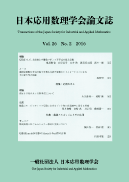Volume 12, Issue 1
Displaying 1-13 of 13 articles from this issue
- |<
- <
- 1
- >
- >|
-
Article type: Cover
2002 Volume 12 Issue 1 Pages Cover1-
Published: March 15, 2002
Released on J-STAGE: April 08, 2017
Download PDF (27K) -
Article type: Cover
2002 Volume 12 Issue 1 Pages Cover2-
Published: March 15, 2002
Released on J-STAGE: April 08, 2017
Download PDF (27K) -
Article type: Appendix
2002 Volume 12 Issue 1 Pages App1-
Published: March 15, 2002
Released on J-STAGE: April 08, 2017
Download PDF (34K) -
Article type: Article
2002 Volume 12 Issue 1 Pages i-
Published: March 15, 2002
Released on J-STAGE: April 08, 2017
Download PDF (133K) -
Article type: Appendix
2002 Volume 12 Issue 1 Pages App2-
Published: March 15, 2002
Released on J-STAGE: April 08, 2017
Download PDF (487K) -
Article type: Article
2002 Volume 12 Issue 1 Pages 1-8
Published: March 15, 2002
Released on J-STAGE: April 08, 2017
Download PDF (762K) -
Article type: Article
2002 Volume 12 Issue 1 Pages 9-28
Published: March 15, 2002
Released on J-STAGE: April 08, 2017
Download PDF (1648K) -
Article type: Article
2002 Volume 12 Issue 1 Pages 29-43
Published: March 15, 2002
Released on J-STAGE: April 08, 2017
Download PDF (1152K) -
Article type: Article
2002 Volume 12 Issue 1 Pages 45-66
Published: March 15, 2002
Released on J-STAGE: April 08, 2017
Download PDF (1659K) -
Article type: Article
2002 Volume 12 Issue 1 Pages 67-78
Published: March 15, 2002
Released on J-STAGE: April 08, 2017
Download PDF (877K) -
Article type: Appendix
2002 Volume 12 Issue 1 Pages App3-
Published: March 15, 2002
Released on J-STAGE: April 08, 2017
Download PDF (43K) -
Article type: Cover
2002 Volume 12 Issue 1 Pages Cover3-
Published: March 15, 2002
Released on J-STAGE: April 08, 2017
Download PDF (28K) -
Article type: Cover
2002 Volume 12 Issue 1 Pages Cover4-
Published: March 15, 2002
Released on J-STAGE: April 08, 2017
Download PDF (28K)
- |<
- <
- 1
- >
- >|
